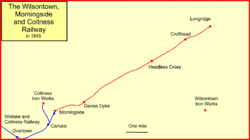Davies Dyke railway station
Davies Dyke railway station[1] or Daviesdyke railway station was a station on the Wilsontown, Morningside and Coltness Railway (WM&CR) that served the rural area of Davies Dyke near Allanton in Lanarkshire, Parish of Cambusnethan.[2] The station was located 1 miles 60 chains[3] east of Morningside railway station.
Davies Dykes Daviesdyke | |
|---|---|
| General information | |
| Location | Allanton, Lanarkshire Scotland |
| Coordinates | 55.7821°N 3.8261°W |
| Grid reference | NS 855 558 |
| Platforms | 1 |
| Other information | |
| Status | Disused |
| History | |
| Original company | Wilsontown, Morningside and Coltness Railway |
| Key dates | |
| 1847[1] | Opened |
| April 1848[1] | Closed to passengers |
The company at first adopted the standard track gauge for mineral lines of 4 ft 6 in, often referred to as Scotch gauge. The Edinburgh and Glasgow Railway took over the WM&CR in 1849, the track gauge already having been changed in August 1847, from the now almost obsolete 4 ft 6 in to the generally accepted standard gauge of 4 ft 8½ in.[4]
Davies Dyke station may have had just a single short platform however this is not clearly indicated, it was accessed by pedestrians only off the farm lane near the Davies Dyke Farm and the road over bridge.[5]
The station is recorded by the NBR study group as opening on 02/06/1845 and closing in May 1848.[6] Another reference states that Davies Dyke closed permanently in March 1848 under the Edinburgh and Glasgow Railway.[7]
Services

The line was worked by steam although the early intention may have been to work the line as a horse drawn waggonway with independent hauliers.
Sporadic passenger services had started from 1845 and a road coach ran between Edinburgh to the original terminus at Longridge from 16 May 1846, passengers disembarking travelling on by train to Townhead. In 1847 two hours was the railway section of the journey, calling at all the stations on the Wilsontown line.[8]
The Caledonian Railway opened its line from Carlisle to Garriongill Junction in 1848 and its trains then ran through to Glasgow over the Wishaw and Coltness Railway. The demands on this abutting line's capacity may have led to the WM&CR passenger service being terminated at this time before being reinstated for a short time a few years later.[9][10]
The passenger service on the line restarted On 1 October 1864 between Morningside and Bathgate on the 1850 extension, with intermediate stations only however at Blackhall, Crofthead, Bents and Whitburn.[11]
Station site and infrastructure
The WMCR stations had no waiting rooms or shelters.[3] The 1859 OS map shows a siding as this site and an ironstone pit nearby[5] In 1897 the site is marked as Davisdyke Siding with a road entrance, a signal light and three signal posts. The ironstone pit had closed by 1897.[12] In 1941 a mineral line branched off towards Kingshill Colliery and a complex arrangement of sidings, a passing loop and running lines were present on this, the LNER Morningside Branch. A signal box is located at the station site.[13]
In 1910 the North British Railway (NBR) Castle Hill branch's junction was located just to the west and a mineral line ran from it to Chapel Colliery. The Auchter Water runs under the embankment near the site.[14]
| Preceding station | Historical railways | Following station | ||
|---|---|---|---|---|
| Morningside Terminus |
Wilsontown, Morningside and Coltness Wilsontown, Morningside and Coltness line |
Headless Cross Towards Longridge | ||
References
- Notes
- Butt (1995), p. 77.
- SABRE
- Report dated 11 June 1845 in Parliamentary Papers Railway Department, Session: 22 January – 28 August 1846
- Knox, Harry (2010). The Story of Bathgate's Railways - 1849 to 2010, Bathgate Historic Conservation Society]
- Lanark Sheet XIII.14 (Cambusnethan). Survey date: 1859. Publication date: 1864).
- "North British Railway. List of Stations with opening and closing dates from 1828 to 2003" (PDF). Archived from the original (PDF) on 4 March 2016. Retrieved 10 May 2015.
- "at cheshire.cent.gla.ac.uk University of Glasgow Archives Hub, Records of the Wishaw & Coltness Railway, and the Wilsontown, Morningside & Coltness Railway". Archived from the original on 28 January 2015. Retrieved 10 May 2015.
- Thomas, John (1984) revised J S Paterson, A Regional History of the Railways of Great Britain: Volume 6, Scotland, the Lowlands and the Borders, Newton Abbott : David and Charles. ISBN 0-946537-12-7.
- Cobb, M.H. (2003). The Railways of Great Britain -- A Historical Atlas. Shepperton : Ian Allan Publishing Limited. ISBN 0-7110-3003-0.
- Butt (1995), p. 149.
- Butt (1995), p. 71.
- Lanarkshire 013.14 (includes: Cambusnethan) Publication date: 1898. Revised: ca. 1897.
- Lanarkshire 013.14 (includes: Cambusnethan). Publication date: 1946. Revised: ca. 1941. Levelled: 1943
- Lanarkshire 019.01 (includes: Cambusnethan). Publication date: 1912. Revised: ca. 1910
- Sources
- Butt, R. V. J. (1995). The Directory of Railway Stations: details every public and private passenger station, halt, platform and stopping place, past and present (1st ed.). Patrick Stephens Ltd. ISBN 1-85260-508-1.
- Cobb, M.H. (2003). The Railways of Great Britain -- A Historical Atlas. Shepperton : Ian Allan Publishing Limited. ISBN 0-7110-3003-0.
- Thomas, John (1984) revised J S Paterson, A Regional History of the Railways of Great Britain: Volume 6, Scotland, the Lowlands and the Borders, Newton Abbott : David and Charles. ISBN 0-946537-12-7.